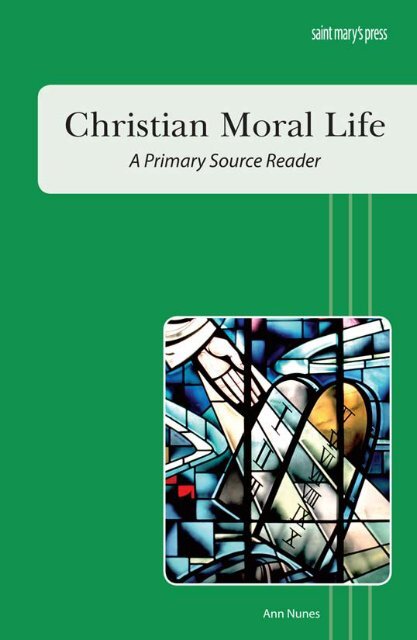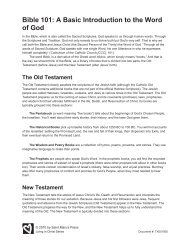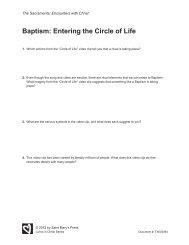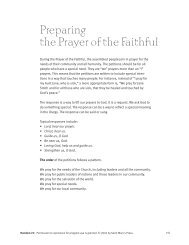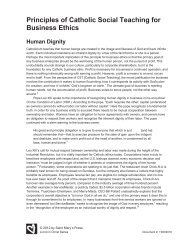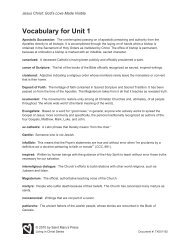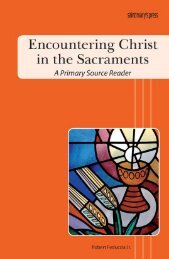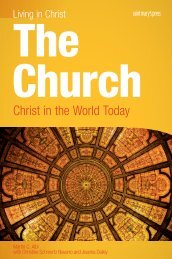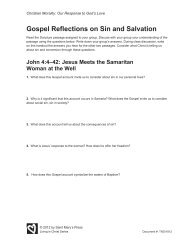Excerpt from The Good Life: Where Morality and Spirituality Converge
Excerpt from The Good Life: Where Morality and Spirituality Converge
Excerpt from The Good Life: Where Morality and Spirituality Converge
You also want an ePaper? Increase the reach of your titles
YUMPU automatically turns print PDFs into web optimized ePapers that Google loves.
Christian Moral <strong>Life</strong>A Primary Source ReaderAnn Nunes
<strong>The</strong> publishing team included Gloria Shahin, editorial director;Jeanette Fast Redmond, development editor. Prepress <strong>and</strong> manufacturingcoordinated by the production departments of SaintMary’s Press.Copyright © 2012 by Saint Mary’s Press, Christian Brothers Publications,702 Terrace Heights, Winona, MN 55987-1320, www.smp.org. All rights reserved. No part of this book may be reproducedby any means without the written permission of the publisher.Printed in the United States of America1363ISBN 978-1-59982-140-5
ContentsIntroduction. 7Part 1: Created in the Image of God, Who Is Love . 111 Loving the <strong>Good</strong> <strong>Life</strong>. 12<strong>Excerpt</strong> <strong>from</strong> <strong>The</strong> <strong>Good</strong> <strong>Life</strong>, by Richard M. Gula, SS2 <strong>The</strong> Divine Embrace . 20<strong>Excerpt</strong> <strong>from</strong> “Message to the Youth of the World on theOccasion of the Fifteenth World Youth Day,” by Blessed JohnPaul II3 Our Divine Dignity. 27<strong>Excerpt</strong> <strong>from</strong> a Discourse, On the Incarnation of the Word,by Saint Athanasius<strong>Excerpt</strong> <strong>from</strong> a Sermon, “Let Us Show Each Other God’sGenerosity,” by Saint Gregory of Nazianzen<strong>Excerpt</strong> <strong>from</strong> a Treatise, On the Holy Spirit, by Saint Basilthe Great4 Christ’s Lovers . 35<strong>Excerpt</strong>s <strong>from</strong> Showings, by Julian of Norwich5 Blessed Are the Meek <strong>and</strong> the Pure of Heart . 42<strong>Excerpt</strong> <strong>from</strong> Introduction to the Devout <strong>Life</strong>, by SaintFrancis de Sales6 Saying Yes to God. 48Luke 1:26–38,40–55“Saint Patrick’s Breastplate,” by Saint Patrick
“Canticle of the Creatures,” by Saint Francis of Assisi“Anima Christi” <strong>and</strong> “Suscipe,” <strong>from</strong> the Spiritual Exercises,by Saint Ignatius of LoyolaPart 2: <strong>The</strong> Law of Love Revealed. 597 What Should I Do?. 60<strong>Excerpt</strong> <strong>from</strong> Making Disciples: A H<strong>and</strong>book of ChristianMoral Formation, by Timothy E. O’Connell8 Naming Our Idols, Claiming Our Heroes. 66“<strong>The</strong> Pillar of the Cloud (Lead, Kindly Light),” by BlessedJohn Henry Newman<strong>Excerpt</strong> <strong>from</strong> Discourse 5, “Saintliness the St<strong>and</strong>ard ofChristian Principle,” by Blessed John Henry Newman9 Honoring Your Family, All for Jesus. 73<strong>Excerpt</strong> <strong>from</strong> Words to Love By . . . , by Blessed Teresa ofCalcutta10 <strong>The</strong> Seamless Garment of <strong>Life</strong> . 80<strong>Excerpt</strong> <strong>from</strong> a Lecture, “A Consistent Ethic of <strong>Life</strong>:Continuing the Dialogue,” by Cardinal Joseph Bernardin11 A Christian Vision of Marriage . 87<strong>Excerpt</strong> <strong>from</strong> Three to Get Married, by Archbishop Fulton J.Sheen12 <strong>The</strong> Little Way of Living the Great Comm<strong>and</strong>ments . 93<strong>Excerpt</strong> <strong>from</strong> <strong>The</strong> Story of a Soul, by Saint Thérèse of Lisieux13 Living <strong>Life</strong> for Others. 100<strong>Excerpt</strong> <strong>from</strong> “Men <strong>and</strong> Women for Others,” by PedroArrupe, SJ
“Love Will Decide Everything,” attributed to PedroArrupe, SJPart 3: Moral Lessons in Loving God <strong>and</strong> Neighbor . 10714 Grace <strong>and</strong> Spirit. 108<strong>Excerpt</strong> <strong>from</strong> Introducing Moral <strong>The</strong>ology: True Happiness<strong>and</strong> the Virtues, by William C. Mattison III15 What Would Jesus Do?. 115<strong>Excerpt</strong>s <strong>from</strong> <strong>The</strong> Imitation of Christ, by Thomas à Kempis16 Hospitality of Heart . 121“Room for Christ,” in <strong>The</strong> Catholic Worker (December1945), by Dorothy Day17 Virtue’s Victory. 128<strong>Excerpt</strong> <strong>from</strong> Scivias, by Hildegard of Bingen18 A Spirit of Discretion. 135<strong>Excerpt</strong> <strong>from</strong> “Discerning God’s Designs,” by Edith Stein(Saint Teresa Benedicta of the Cross, OCD)19 <strong>The</strong> Primacy of Conscience. 141<strong>Excerpt</strong>s <strong>from</strong> Letters <strong>from</strong> the Tower of London, by SaintThomas More<strong>Excerpt</strong> <strong>from</strong> A Man for All Seasons, by Robert Bolt20 Talking with Jesus . 148<strong>Excerpt</strong> <strong>from</strong> Conversing with God as a Friend, by SaintAlphonsus de Liguori
Part 4: Sin <strong>and</strong> Hope in the Redemptive Love of Christ. 15521 Disabling Vice <strong>and</strong> Enabling Virtue. 156<strong>Excerpt</strong> <strong>from</strong> <strong>The</strong> Primacy of Love: An Introduction to theEthics of Thomas Aquinas, by Paul J. Wadell<strong>Excerpt</strong> <strong>from</strong> Summa <strong>The</strong>ologica, by Saint Thomas Aquinas22 A Conversion of Heart . 163<strong>Excerpt</strong>s <strong>from</strong> <strong>The</strong> Confessions, by Saint Augustine of Hippo23 Lost <strong>and</strong> Found. 171<strong>Excerpt</strong>s <strong>from</strong> <strong>The</strong> Book of Her <strong>Life</strong>, by Saint Teresa of Ávila24 Dispelling Envy in the Soul. 179A Sermon, “A Public Plague,” by Saint John Vianney, theCuré of Ars25 <strong>The</strong> Cross <strong>and</strong> the Resurrection. 186John 8:1–11<strong>Excerpt</strong>s <strong>from</strong> “A Pastor’s Last Homily,” by Archbishop OscarRomeroPhilippians 3:8–14For Further Reading . 194Acknowledgments. 196
Introduction<strong>The</strong>refore, since we are surrounded by so great a cloudof witnesses, let us rid ourselves of every burden <strong>and</strong> sinthat clings to us <strong>and</strong> persevere in running the race thatlies before us while keeping our eyes fixed on Jesus, theleader <strong>and</strong> perfecter of faith. (Hebrews 12:1–2)Imagine that you are running a race in a crowded stadium. Feel thepounding of your feet against the track. Just a quarter of the wayinto the race, you start to feel tired <strong>and</strong> wonder if you can evenmake it to the finish line.Suddenly you begin to hear your name called <strong>from</strong> the st<strong>and</strong>s.People are cheering you on, but you do not know who they are.<strong>The</strong>y are calling your name, saying: “You can make it! It’s in you!Keep going! You can win!” Who are these people? How do theyeven know your name? Why are they so confident that you caneven finish the race, much less win?It is working, though. You can feel their confidence in you, asif the wind is at your back. You can make it. You might even win!In the moral race too—the race to overcome sin <strong>and</strong> be afaithful follower of Christ—there is a crowd cheering us on. <strong>The</strong>Letter to the Hebrews calls this cheering crowd a “cloud of witnesses”(12:1). <strong>The</strong>y are the voices of the holy men <strong>and</strong> womenthroughout history who have gone before us marked with the signof faith. <strong>The</strong>y have persevered. <strong>The</strong>y have run the good race. <strong>The</strong>yhave claimed their prize <strong>and</strong> are now cheering us on as we runlife’s race. <strong>The</strong>y are calling us to victory.This cloud of witnesses is part of a larger community that theChurch calls the Communion of Saints. We are one family thatlooks out for one another: asking for help <strong>from</strong> those who can giveit, <strong>and</strong> giving help to those who need it. Heaven <strong>and</strong> earth areunited in this familial reality, the Communion of Saints.All the members of this family have your back as you run life’smoral race. You do not have to run it alone. <strong>The</strong> Christian moral7
life is defined by loving relationships. Human relationships are notalways the image of perfect love, <strong>and</strong> we sometimes feel discouraged<strong>and</strong> disappointed by people in our lives. We may feel wearywith our relationships <strong>and</strong> think we have no one to turn to. But wehave God. God is always there <strong>and</strong> wants us to know that we havemany more friends than social networks could ever count—for weare part of the Communion of Saints. We are supported by faithfulpeople—living <strong>and</strong> dead—who can offer us insight about runninglife’s moral race.This primary source reader, Christian Moral <strong>Life</strong>, includesletters, sermons, <strong>and</strong> other writings of many holy people. Each ofthe reader’s four parts begins with a reading <strong>from</strong> a contemporarymoral theologian. <strong>The</strong>se modern authors are then followed by othersin the cloud of witnesses, that great crowd of faithful men <strong>and</strong>women who are cheering you on.• Part 1 considers what we mean when we talk about “life inChrist.” In these readings Blessed John Paul II, Julian of Norwich,the Blessed Virgin Mary, <strong>and</strong> others examine the fulfillmentof God’s promises in Christ <strong>and</strong> what it means to respondwith love, just as Mary said yes to God’s plan.• Part 2 goes on to discuss how God taught us to live this newlife in Christ. <strong>The</strong> Two Great Comm<strong>and</strong>ments <strong>and</strong> the Beatitudesare among the topics explored here by Blessed JohnHenry Newman, Blessed Teresa of Calcutta, Saint Thérèse ofLisieux, Pedro Arrupe, SJ, <strong>and</strong> others.• Part 3 examines how this new life in Christ <strong>and</strong> the Gospelmessage are at the heart of Catholic moral teaching. Selections<strong>from</strong> Hildegard of Bingen, Saint Thomas More, Saint Alphonsusde Liguori, <strong>and</strong> others talk about the virtues, the importanceof developing <strong>and</strong> following one’s conscience, <strong>and</strong> therole of prayer in making moral decisions.• Finally, Part 4 explores the reality of sin through the writings ofself-professed sinners like Saint Augustine <strong>and</strong> Saint Teresa ofÁvila. But their readings, as well as sermons <strong>from</strong> Saint John8 Christian Moral <strong>Life</strong>: A Primary Source Reader
Vianney <strong>and</strong> Archbishop Oscar Romero, also call us to conversion<strong>and</strong> cheer us on with the hope of redemption.Two thous<strong>and</strong> years of Church history are represented throughthese writings. Although each author reflects the period of timein which he or she wrote, every author shares wisdom that transcendstime <strong>and</strong> place, wisdom that is relevant to your moral lifetoday.Although many authors in this book have departed this life,they are very much alive <strong>and</strong> present to you in spirit. If you openyour ears <strong>and</strong> your heart, you will know they are cheering you on.<strong>The</strong>y really do have your back. <strong>The</strong>y can help you run life’s moralrace with your eyes fixed on Christ.Introduction 9
Part 1Created in the Image of God,Who Is Love
1Loving the <strong>Good</strong> <strong>Life</strong>Introduction“<strong>The</strong> good life”—what images come to mind when you think ofthat phrase? <strong>The</strong> reading in this chapter comes <strong>from</strong> a book called<strong>The</strong> <strong>Good</strong> <strong>Life</strong>: <strong>Where</strong> <strong>Morality</strong> <strong>and</strong> <strong>Spirituality</strong> <strong>Converge</strong>, by Fr.Richard Gula, a moral theologian, professor, <strong>and</strong> author knownfor considering modern questions <strong>and</strong> dilemmas through the eyesof faith in Jesus Christ. While writing <strong>The</strong> <strong>Good</strong> <strong>Life</strong>, Gula took aninformal survey that posed a similar question about this phrase. Asyou read the selection in this chapter, see how your idea of “thegood life” lines up with that of others.This introductory reading begins with the idea that love makesthe good life possible. According to Gula, despite what popularculture may tell us, the good life is one of communion with God,who is always extending his divine h<strong>and</strong> in love <strong>and</strong> friendship.Jesus Christ is God’s love in the flesh; Christ shows us how to begood friends with God the Father. Throughout the Gospel of John,Jesus calls his disciples “friends” <strong>and</strong> instructs them, “As I haveloved you, love one another” (John 13:34). <strong>The</strong> good life is thereforea life of giving <strong>and</strong> receiving love.Although abundance does mark the good life, constantlychanging media images <strong>and</strong> values surround us with only an illusionof abundance. Gula reminds us that the steadfast <strong>and</strong> abundantlove of God is already within us. If we are open to it, thislove becomes a wellspring to help us live authentically as peopleof character <strong>and</strong> virtue. When we live authentically in the imageof God, in whom we are created, <strong>and</strong> when we embody thelove of God in the world today, we walk the moral path. Rootedin this reality of divine love, our moral actions flow <strong>from</strong> the es-12
sence of who we are—orrather, whose we are.God invites us to be hisfriends. If we accept thisinvitation, our morality isdefined by this friendship.<strong>Morality</strong> is relational; thatis, our relationships withGod, with others, <strong>and</strong> with ourselves inform our moral choices.As a professor of ethics <strong>and</strong> moral theology, Gula has taughtthat this relational underst<strong>and</strong>ing of morality is central. Any studentwho has walked into his introductory class on moral theologyanticipating a dry recitation of regulations <strong>and</strong> rules in theCatholic Church has been pleasantly surprised to discover thathe really teaches guidelines about being in right relationshipsthat are rooted in the love of God as revealed in the life of JesusChrist. Through his vocation as a priest, as well as his speeches,classroom teaching, <strong>and</strong> many published books, Gula has guidedpeople of all ages to recognize God’s love at work in their lives<strong>and</strong> to respond with character, virtue, <strong>and</strong> moral integrity—in essence,to lead good lives.<strong>Morality</strong>, the truly good life, is rooted in love. Christian moralityis synonymous with life in Christ. As Gula explains in the followingexcerpt, “<strong>The</strong> good life for a Christian takes its shape <strong>from</strong>our allegiance to Jesus the Christ” (p. 6). This allegiance forms <strong>and</strong>transforms our character so that we truly love living the good life.<strong>Excerpt</strong> <strong>from</strong> <strong>The</strong> <strong>Good</strong> <strong>Life</strong>: <strong>Where</strong><strong>Morality</strong> <strong>and</strong> <strong>Spirituality</strong> <strong>Converge</strong>By Richard M Gula, SSright relationships Relationships alignedto help each human being to thrive inmind, body, <strong>and</strong> spirit.vocation A call <strong>from</strong> God to all membersof the Church to embrace a life ofholiness.“Someone in Nebraska loves me.” So read the bumper sticker on the carin front of me while I was driving along one of California’s freeways thisafternoon. I thought, what a great way to begin this short book on theLoving the <strong>Good</strong> <strong>Life</strong> 13
first principle A foundational principle<strong>from</strong> which other truths can proceed.moral life. After all, being loved makes the moral life possible! For themoral life is really about living out of the abundance of being loved inways that make life richer for everyone. How are we ever going to live inways that promote the well being <strong>and</strong> full flourishing of ourselves <strong>and</strong>others, as well as the whole environment, if we do not first feel the love ofanother for us?Now, Nebraska is a long way <strong>from</strong> California, but that distancequickly shrinks with the thought that someone there holds us close totheir heart. To know that someone loves us, that we are special to them,not only brings them close to us but also strengthens, consoles, <strong>and</strong> empowersus to live out of the gifts that are ours. It is so much easier to takethe risk to love another, even a stranger, when we know that someone,somewhere, loves <strong>and</strong> cherishes us.As the experience of lovers tells us, loving another <strong>and</strong> being lovedby another creates a dynamism that opens us beyond the particularity ofthe one we love <strong>and</strong> moves us outward toward the goodness <strong>and</strong> lovablenessof all people—in fact, of all creation. <strong>The</strong> moral life depends on theexperience of being loved <strong>and</strong> on the dynamic pull that draws us to love allthings, <strong>and</strong> ultimately to love God.. . . Spiritual masters throughout the ages have told us in a varietyof ways that God’s love for us does not compete with the relationships wehave with other people or creation. We do not have to step over or aroundthem in order to get to God. Rather, God comes to us in <strong>and</strong> through ourrelationships with all things.But to say “God loves you!” may seem trite. We have heard it so manytimes that it may very well suggest an empty piety. Yet, the good news ofthe Christian faith is that God’s love is real, creative, constant, <strong>and</strong> undefeatable.God’s loving us is the supreme truth, the rock bottom foundation,the first principle on which we build a moral <strong>and</strong> spiritual life. Aswith any first principle, we cannot prove it but we can deduce <strong>from</strong> it.Once we accept it, we can see how much follows <strong>from</strong> it. We can see thatall of life is lived in the presenceof God, is a responseto God, <strong>and</strong> has value inrelation to God’s love.14 Christian Moral <strong>Life</strong>: A Primary Source Reader
<strong>The</strong> good life, then, is a graced life—a life that expresses the divinelove within us. But is that what you really think of when you hear theexpression “the good life”? . . . I took an informal survey of spontaneousassociations of the good life. Images that most frequently surfaced wereall influenced by the commercialism of our popular culture—owning aluxury car or a mountain villa, taking an exotic vacation or a cruise, beingtreated with first class service, dining in gourmet restaurants, <strong>and</strong> drinkingfine wine.<strong>The</strong>se images came as no surprise because television <strong>and</strong> commercialads are usurping the role of religion <strong>and</strong> the church in shaping our imaginations<strong>and</strong> our system of values. <strong>The</strong> kind of life they promote is oftenbased on anti-Christian values such as greed, consumerism, <strong>and</strong> elitism.<strong>The</strong>se contradict Christian teaching about solidarity, about st<strong>and</strong>ing withthe poor, <strong>and</strong> about being a beatitude people. Christians, however, believethat the images that come to us in our religious stories provide truthfulways of seeing the world <strong>and</strong> ordering our values <strong>and</strong> that to use religiousstories <strong>and</strong> images for interpreting what is going on can help us to engagethe world as a people formed by Christian faith.<strong>The</strong> good life . . . is fundamentally a vocation—a response to whatwe hear God speak to us. What we hear <strong>and</strong> how we respond are influencedby Christian stories <strong>and</strong> images. <strong>The</strong> good life is possible becauseGod has made the first move. Our moving toward God begins with Godmoving outward into creation toward us, preeminently in Jesus but also in<strong>and</strong> through all the people <strong>and</strong> events of our lives. From the perspective ofvocation, wherein God calls <strong>and</strong> we respond, the basic question governingthe good life is “What is God calling us to be <strong>and</strong> to do?” <strong>The</strong> relationshipwe establish with God in <strong>and</strong> through our responses to all things becomesthe center of the good life. <strong>The</strong> mystery of grace assures us that divine loveis always with us, inviting us <strong>and</strong>leading us toward the realizationof the fullness of lifein communion with God.Living the good life, simplyput, is graced living expressingthe divine love within us.solidarity Union of one’s heart <strong>and</strong> mindwith all people; a principle of Catholicsocial teaching based on the well-beingof all people <strong>and</strong> the concept of the commongood.Loving the <strong>Good</strong> <strong>Life</strong> 15
Christian spirituality <strong>and</strong><strong>Morality</strong> <strong>and</strong> <strong>Spirituality</strong> Christian morality converge in theCan you be a moral person good life. <strong>Spirituality</strong> is concernedbut not spiritual? Can youwith the wellspring of our actions.be a spiritual person but notIf we focus only on the actions thatact morally? <strong>Morality</strong> refersto the goodness or evil of humanacts. Moral decisions can nourishes <strong>and</strong> sustains those actions.get done, then we neglect whatbe made based on principles <strong>The</strong>re is more to us, <strong>and</strong> more toother than those guided by life, than what we do. Our interiorfaith <strong>and</strong> a particular spirituality.And some people wholife affects our exterior behavior. Ifwe underst<strong>and</strong> that the purpose ofclaim to be spiritual do notnecessarily make moral choices life is to live in friendship with God,guided by their faith. When we then there can be no real separationlive an authentically Christian of the moral <strong>and</strong> spiritual life. Ourlife, however, spirituality <strong>and</strong> searching for meaning, hungeringthe gospel of Jesus Christ dofor love, yearning to connect, orinform our morality.seeking fulfillment are, themselves,responses to God’s self-giving love.For many people, however, the moral <strong>and</strong> spiritual life remain in twoseparate spheres. Some locate the spiritual life in the world of devotions,such as taking time for prayer or fasting. A spiritual life of this sort caneasily become a substitute for vital moral living. But spirituality is muchmore about our fundamental commitment to God in Christ; it is anoutlook on life <strong>and</strong> the very style of life that such a commitment nurturesin us.When we separate morality <strong>and</strong> spirituality into separate spheres oflife, we begin to reduce the moral life to sins or individual acts of virtue inspecific areas of life—business dealings, sexual relations, making life-<strong>and</strong>deathdecisions, <strong>and</strong> the like. We expect morality to provide a set of rulesor principles that we only need to apply in order to determine the rightway to act. In fact, so many books about morality still put the spotlighton individual acts, rules, principles, problems, <strong>and</strong> strategies for resolvingthem <strong>and</strong> then leave the nobler life to spirituality. But so much of our everydaymoral living does not fall within those realms marked off by clearlydefined rules or principles for direct action.16 Christian Moral <strong>Life</strong>: A Primary Source Reader
. . . Just as one’s spirituality cannot be reduced to one’s disciplineof prayer, so the moral life cannot be reduced to acts or summed up inthe decisions we make <strong>and</strong> the justifications we give to support the waywe solve our problems.Our ability to identify aproblem, <strong>and</strong> even moreto solve it, is a measure ofwho we are <strong>and</strong> how welive in the meantime. . . . [My teaching concerns] the kind of personswe ought to become <strong>and</strong> the kind of life we ought to live <strong>from</strong> day to dayby virtue of our commitment to God in Christ <strong>and</strong> through the Spirit. Inthis sense, the moral life has to do with what also pertains to spirituality—a deeper vision of life, basic attitudes toward life, <strong>and</strong> the style of life thatis grounded in our commitment to God. . . . When it comes to livingthe good life, character <strong>and</strong> virtue matter; that is to say, the moral life <strong>and</strong>spiritual life converge when we begin to explore the sort of persons weought to become <strong>and</strong> the sort of lives we ought to live in order to flourishas authentic human beings.While emphasizing character <strong>and</strong> virtue, I am not advocating that thenormative morality of duty <strong>and</strong> principles be dismissed. Virtue, duty, <strong>and</strong>principles are complementary aspects of the same morality. Virtues expressthose habits, affections, attitudes, <strong>and</strong> convictions that lead to genuine humanfulfillment, that is, to being one with God <strong>and</strong> so with one another<strong>and</strong> with the environment. With virtue, we carry out religious devotionsor do our moral duty not because someone is comm<strong>and</strong>ing us to do themor is keeping a watchful eye over us to assure that we do them. Rather,with virtue, we act out of an internal, self-directing commitment to thevalues at stake. Virtue ethics stresses that who we are overflows into whatwe do. Virtues link us to action by providing a sensitivity to what is right<strong>and</strong> a motivation to do what human well-being dem<strong>and</strong>s. Whether or notan obligation is prescribedby duties or principles, <strong>and</strong>whether or not anyone iswatching, virtue makes usalert <strong>and</strong> responsive to theWhen it comes to living the good life,character <strong>and</strong> virtue matter.morality of duty Actions based uponmoral obligations rather than virtue orlove.Loving the <strong>Good</strong> <strong>Life</strong> 17
moral claims of situations, often with little attention to rationalizing,calculating, or counting the cost. With virtue, we act naturally. We do notponder, argue, or fuss. We simply move.What is making a perspective <strong>from</strong> character <strong>and</strong> virtue so necessary?For one thing, our world is changing very rapidly. <strong>The</strong>re is no way we couldever have answers today to questions <strong>and</strong> issues that we will have to face inthe future. We don’t even know what those questions <strong>and</strong> issues are going tobe. Think back only thirty years or so. Who would ever have thought thatwe would now be facing what to do with frozen embryos, whether we oughtto clone humans, or how to protect privacy or prevent harassment over theInternet? But by directing our attention to virtuous character, we may becomethe sort of people who will be able to make right decisions on matters that wehave never anticipated. To this end, we will have to illuminate the backgroundissues of the moral life, such as our moral vision, attitudes, motivations, affections,intentions, convictions, <strong>and</strong> habits that give a particular shape to ourlives. When we highlight these aspects of our selves, we are illuminating ourspirituality as well.. . . [My] conviction is that the good life is a life of friendship withGod <strong>and</strong> that we will become friends with God <strong>and</strong> with one another to theextent that we develop our character <strong>and</strong> virtues. . . . <strong>The</strong> good life for aChristian does not derive <strong>from</strong> some general concept of the good, such aswhat is pleasurable or useful. Rather, the good life for a Christian takes itsshape <strong>from</strong> our allegiance to Jesus the Christ, whom we believe to be the decisiverevelation of God’s love for us <strong>and</strong> the fullest human response to that love.By freely entering into relationship with Jesus through the power of the HolySpirit, we become disciples today. As such, we share in the life of love offeredby God the Father. Every love changes us, but only God’s love for us changesus into God’s friends. This friendship with God will only be completely realizedin heaven, that is, when the reign of divine love comes in its fullness.Among the deepest questions we face in the meantime are questionsabout the meaning of life, about the sort of person we ought to become, <strong>and</strong>about how we ought to conduct our lives. In <strong>and</strong> through the biblical witness,especially the preaching, teaching, <strong>and</strong> works of Jesus, we see what lifelooks like when pointed in the direction of being a friend of God <strong>and</strong> of oneanother.18 Christian Moral <strong>Life</strong>: A Primary Source Reader
For Reflection1. According to Gula, what is the “supreme truth,” the “first principle,”on which a Christian moral <strong>and</strong> spiritual life is built? Why mightthis be considered a first principle?2. Compare <strong>and</strong> contrast the moral <strong>and</strong> spiritual life, as explained inthis excerpt.3. Based on what Gula says in this reading, what is replacing religionin shaping our values? What kind of life do these replacementspromote, <strong>and</strong> how do they compare to Christian teachings? Do youagree or disagree with the author?4. From the perspective of vocation, what does Gula say is the basicquestion governing the good life? How would you answer that question?Loving the <strong>Good</strong> <strong>Life</strong> 19
2<strong>The</strong>Divine EmbraceIntroduction“We love you, John Paul Two! We love you!” chanted a crowd ofCatholic university students during Pope John Paul II’s first visit tothe United States. Spontaneously he responded, “John Paul Two,he loves you!” <strong>The</strong> 263rd successor to Saint Peter has been calledthe “Pope of the Youth.” <strong>The</strong> world’s youth were near to his heart;he frequently called young people his dear friends.Named Karol Wojtyła at his birth in 1920, Blessed John Paul IIwas destined to live a cosmopolitan life in every sense. <strong>The</strong> mosttraveled Pope in history, he visited 130 countries during his pontificate<strong>and</strong> spoke at least seven languages fluently. At his invitation160 religious leaders of various faith traditions worldwide came toAssisi, Italy, for the first WorldWorld Youth DayIn 1986 young people <strong>from</strong>around the world acceptedPope John Paul II’s invitationto come celebrate their faithwith him in Rome. WorldYouth Day was born. Eachyear since, young people offaith have gathered for WYDeither in their dioceses for aday or on weeklong pilgrimagesin host cities around theworld. <strong>The</strong> world’s youth whoembark on the WYD journeyjoyfully share the diversity oftheir cultures <strong>and</strong> the unity oftheir faith.Day of Prayer for Peace. And heinitiated World Youth Day, invitingyoung people <strong>from</strong> aroundthe world to gather in host cities(such as Denver, Paris, Manila,Sydney, <strong>and</strong> Madrid) for a joyfulcelebration of faith <strong>and</strong> culture.This chapter’s excerpt comes<strong>from</strong> Pope John Paul II’s messageto young people at thefifteenth World Youth Day, heldin 2000 in Rome. <strong>The</strong> scripturaltheme running through all theevents of that World Youth Daywas adapted <strong>from</strong> the Gospel of20
John: “<strong>The</strong> Word becameflesh, <strong>and</strong> dwelt amongus” (1:14). <strong>The</strong> theme wasa reminder that God’spromise <strong>and</strong> plan are todwell among us, lovinglyembrace us, <strong>and</strong> sharewith us the happiness ofHeaven.In this reading PopeJohn Paul II encouragesus to open our heartsto God’s plan of love,revealed most fully in thelife, death, <strong>and</strong> Resurrectionof Jesus. He seeks tocosmopolitan Having a worldly outlookor broad cultural frame of reference.redemption From the Latin redemptio,meaning “a buying back,” referring, in theOld Testament, to Yahweh’s deliveranceof Israel <strong>and</strong>, in the New Testament, toChrist’s deliverance of all people <strong>from</strong> theforces of sin.saints From the Latin sanctus, meaningholy; someone who has been transformedby the grace of Christ <strong>and</strong> who resides infull union with God in Heaven. In thisreading, it refers to being saintly or holypeople here <strong>and</strong> now.inspire us to be faithful to the Christian message, to live in solidarity,<strong>and</strong> to be cosmopolitan in the Christian sense—united withpeople of every culture through God’s redemptive love. He remindsus that the cross of Christ—the symbol of Christian redemption—bringstogether Heaven <strong>and</strong> earth. <strong>The</strong> outstretched arms ofJesus on the cross envelop all of humanity <strong>and</strong> tenderly hold thecosmos “in a divine embrace” (2). <strong>The</strong> Passion of Christ demonstratesthis divine love <strong>and</strong> reminds us that God intimately knowsour human suffering. Through our own sorrows <strong>and</strong> suffering, wetoo can know Jesus Christ.Pope John Paul II calls us to be saints: “May it be your holyambition to be holy, as He is holy” (3). As God is holy, we arecalled to be holy, to be sancti, to be saints. Just as Christ sent forththe Apostles to proclaim his <strong>Good</strong> News two thous<strong>and</strong> years ago,the Pope sends us forth to build a new humanity founded on thelove <strong>and</strong> forgiveness received in the divine embrace of Christ.<strong>The</strong> Divine Embrace 21
<strong>Excerpt</strong> <strong>from</strong> “Message to the Youth of theWorld on the Occasion of the FifteenthWorld Youth Day”By Blessed John Paul II2. . . . I make again to you my pressing appeal to open wide the doorsto Christ who “to those who received him, gave power to become childrenof God” (Jn 1:12). To receive Jesus Christ means to accept <strong>from</strong> the Fatherthe comm<strong>and</strong> to live, loving Him <strong>and</strong> our brothers <strong>and</strong> sisters, showingsolidarity to everyone, without distinction; it means believing that in thehistory of humanity even though it is marked by evil <strong>and</strong> suffering, thefinal word belongs to life <strong>and</strong> to love, because God came to dwell amongus, so we may dwell in Him.By his incarnation Christ became poor to enrich us with his poverty,<strong>and</strong> he gave us redemption, which is the fruit above all of the bloodhe shed on the Cross (cfr Catechism of the Catholic Church 517). OnCalvary, “ours were the sufferings he bore . . . he was pierced throughfor our faults” (Is 53:4–5). <strong>The</strong> supreme sacrifice of his life, freely givenfor our salvation, is the proof of God’s infinite love for us. Saint John theApostle writes: “God loved the world so much that he gave his only Sonso that everyone that believes in him may not be lost but may have eternallife” (Jn 3:16). He sent Him to share in every way, except sin, our humancondition; he “gave” him totally to men, despite their obstinate <strong>and</strong>homicidal rejection (cfr Mt 21:33–39), to obtain, through his death, theirreconciliation. “<strong>The</strong> God of creation is revealed as the God of redemption,as the God who is ‘faithful to himself’ <strong>and</strong> faithful to his love for man <strong>and</strong>the world which he revealed on the day of creation . . . how preciousmust man be in the eyes of the Creator, if he gained so great a Redeemer”(Redemptor hominis 9.10).Jesus went towards his death. He did not draw back <strong>from</strong> any of theconsequences of his beingCalvary <strong>The</strong> place outside the city wallsof Jerusalem where Jesus was crucified.“with us,” Emmanuel. Hetook our place, ransomingus on the Cross <strong>from</strong> evil22 Christian Moral <strong>Life</strong>: A Primary Source Reader
<strong>and</strong> sin (cfr Evangelium vitae 50). Just as the Roman Centurion, seeingthe manner in which Jesus died, understood that he was the Son of God(cfr Mk 15:39) so we too, seeing <strong>and</strong> contemplating the Crucified Lord,underst<strong>and</strong> who God really is, as he reveals in Jesus the depth of his lovefor mankind (cfr Redemptor hominis 9). “Passion” means a passionate love,unconditioned self-giving: Christ’s passion is the summit of an entirelife “given” to his brothers <strong>and</strong> sisters to reveal the heart of the Father.<strong>The</strong> Cross, which seems to rise up <strong>from</strong> the earth, in actual fact reachesdown <strong>from</strong> heaven, enfolding the universe in a divine embrace. <strong>The</strong> Crossreveals itself to be “the centre, meaning <strong>and</strong> goal of all history <strong>and</strong> of everyhuman life” (Evangelium vitae 50).“One man has died for all” (2 Cor 5:14): Christ “gave himself up inour place as a fragrant offering <strong>and</strong> a sacrifice to God” (Eph 5:2). Behindthe death of Jesus there is a plan of love, which the faith of the Churchcalls the “mystery of the redemption”: the whole of humanity is redeemed,that is, set free <strong>from</strong> the slavery of sin <strong>and</strong> led into the kingdom of God.Christ is Lord of heaven <strong>and</strong> earth. Whoever listens to his word <strong>and</strong>believes in the Father, who sent him, has eternal life (cfr Jn 5:25). He isthe “Lamb of God who takes away the sins of the world” (Jn 1:29.36), thehigh priest who, having suffered like us, is able to share our infirmity (cfrHeb 4:14) <strong>and</strong> “made perfect” through the painful experience of the Cross,becomes “for all who obey him, the source of eternal salvation” (Heb 5:9).3. Dear young people, faced with these great mysteries, learn to liftyour hearts in an attitude of contemplation. Stop <strong>and</strong> look with wonderat the infant Mary brought into the world, wrapped in swaddling clothes<strong>and</strong> laid in a manger: the infant is God himself who has come among us.Look at Jesus of Nazareth, received by some <strong>and</strong> scorned by others, despised<strong>and</strong> rejected: He is the Saviour of all. Adore Christ, our Redeemer,who ransoms us <strong>and</strong> frees us <strong>from</strong> sin <strong>and</strong> death: He is the living God, thesource of <strong>Life</strong>.Contemplate <strong>and</strong> reflect! God created us to share in his very ownlife; he calls us to be his children, living members of the mystical Bodyof Christ, luminous temple of the Spirit of Love. He calls us to be his: hewants us all to be saints. Dear young people, may it be your holy ambitionto be holy, as He is holy.<strong>The</strong> Divine Embrace 23
You will ask me: but is it possible today to be saints? If we had to relyonly on human strength, the undertaking would be truly impossible. Youare well aware, in fact, of your successes <strong>and</strong> your failures; you are awareof the heavy burdens weighing on man, the many dangers which threatenhim <strong>and</strong> the consequences caused by his sins. At times we may be grippedby discouragement <strong>and</strong> even come to think that it is impossible to changeanything either in the world or in ourselves.Although the journey is difficult, we can do everything in the Onewho is our Redeemer. Turn then to no one, except Jesus. Do not lookelsewhere for that which only He can give you, because “of all the namesin the world given to men this is the only one by which we can be saved”(Acts 4:12). With Christ, saintliness—the divine plan for every baptizedperson—becomes possible. Rely on Him; believe in the invincible powerof the Gospel <strong>and</strong> place faith as the foundation of your hope. Jesus walkswith you, he renews your heart <strong>and</strong> strengthens you with the vigour of hisSpirit.Young people of every continent, do not be afraid to be the saints ofPope John Paul II <strong>and</strong> theSaintsDuring his twenty-six-yearpontificate, Blessed John PaulII canonized more saints thanany other Pope in modern history.He wanted the people ofour time <strong>and</strong> of all nations tohave models of faith <strong>and</strong> spiritualfriends for life’s journey.During his own lifetime, JohnPaul II touched the hearts ofso many that when he died in2005, people around the worldspontaneously cried out, “SantoSubito!” (“Sainthood now!)He was beatified in 2011, thefirst step toward possible canonization.the new millennium! Be contemplative,love prayer; be coherent withyour faith <strong>and</strong> generous in the serviceof your brothers <strong>and</strong> sisters, beactive members of the Church <strong>and</strong>builders of peace. To succeed in thisdem<strong>and</strong>ing project of life, continueto listen to His Word, draw strength<strong>from</strong> the Sacraments, especially theEucharist <strong>and</strong> Penance. <strong>The</strong> Lordwants you to be intrepid apostlesof his Gospel <strong>and</strong> builders of anew humanity. In fact, how couldyou say you believe in God mademan without taking a firm positionagainst all that destroys the humanperson <strong>and</strong> the family? If youbelieve that Christ has revealed the24 Christian Moral <strong>Life</strong>: A Primary Source Reader
Father’s love for every person, you cannot fail to strive to contribute to thebuilding of a new world, founded on the power of love <strong>and</strong> forgiveness, onthe struggle against injustice <strong>and</strong> all physical, moral <strong>and</strong> spiritual distress,on the orientation of politics, economy, culture <strong>and</strong> technology to theservice of man <strong>and</strong> his integral development.4. . . . From the whole Church may there rise up “a hymn of praise<strong>and</strong> thanksgiving to the Father, who in his incomparable love grantedus in Christ to be ‘fellowcitizens with the saints <strong>and</strong>members of the householdof God’” (IncarnationisMysterium 6). May wedraw comfort <strong>from</strong> theWith Christ, saintliness—the divineplan for every baptized person—becomespossible.certainty expressed by Saint Paul the Apostle: If God did not spare hisonly Son but gave him for us, how can he fail to give us everything withhim? Who can separate us <strong>from</strong> the love of Christ? In every event of life,including death, we can be more than winners, by virtue of the One wholoved us to the Cross (cfr Rom 8:31–37).<strong>The</strong> mystery of the Incarnation of the Son of God <strong>and</strong> that of theRedemption he worked for all men, constitute the central message of ourfaith. <strong>The</strong> Church proclaims this down through the centuries, walking“amidst the misunderst<strong>and</strong>ings <strong>and</strong> persecutions of the world <strong>and</strong> theconsolations of God” (S. Augustine De Civ. Dei 18, 51, 2; PL 41,614) <strong>and</strong>she entrusts it to her children as a precious treasure to be safeguarded <strong>and</strong>shared.You too, dear young people, are the receivers <strong>and</strong> the trustees of thisheritage: “This is our faith. This is the faith of the Church. And we areproud to profess it, in Jesus Christ Our Lord” (Roman Pontifical, Rite ofConfirmation).<strong>The</strong> Divine Embrace 25
For Reflection1. According to the Pope, what proves the infinite love God has for us?In your own words, explain why this is considered proof of God’slove. How does he say we should respond to this proof?2. John Paul II calls all of us to be “the saints of the new millennium.”What are we called to do? How can you personally respond to thissummons?3. Based on this reading, what is the central message of our faith?26 Christian Moral <strong>Life</strong>: A Primary Source Reader


